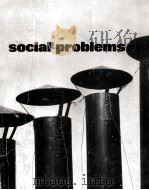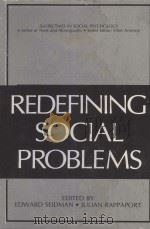《CONTEMPORARY SOCIAL PROBLEMS》
| 作者 | VINCENT N.PARRILLO JOHN STIMS 编者 |
|---|---|
| 出版 | JOHN WILEY & SONS |
| 参考页数 | 644 |
| 出版时间 | 没有确切时间的资料 目录预览 |
| ISBN号 | 无 — 求助条款 |
| PDF编号 | 819596048(仅供预览,未存储实际文件) |
| 求助格式 | 扫描PDF(若分多册发行,每次仅能受理1册) |

PART ONE SOCIOLOGY OF SOCIAL PROBLEMS2
CHAPTER 1 Definitions and Perspectives5
Impediments to Defining Social Problems6
What We Feel We Can Do6
Societal Problems6
The Fallacy of Inevitabihty7
The Role of the Social Scientist7
Value Judgments7
The Limits of Observation8
Objectivity and Theory12
The Four Elements of a Social Problem13
The Persistence of Social Problems14
Individual or Social Damage16
Offense to a Powerful Group's Standards18
False Causes and Misdirected Interventions19
Cultural Lags: Myth of the Undeserving19
Quasi-Theories21
The Myth of the Invisible Hand22
Sociological Orientations to Social Problems22
Introduction:Four Views of Social Order22
Individual Faults and Deviant Behavior Emphasis23
Institutional Faults and System Disorganization Emphasis27
Inequality and Inevitable Conflict Emphasis29
Interaction and Social Interpretation Emphasis30
The Future of Social Problems32
Rules for the Future32
Methods for Studying the Future ed Social Problems33
Summary34
Suggested Readings35
Glossary36
CHAPTER 2 The Individual in Modem Society: Alienation and Anornie39
The Quality of Individuals' Lives40
Types of Life Satisfactions40
The Impact of Society on the Individual41
Shyness: A Cultural Fact44
Embedded and Enmeshed in Society44
Anoints: Disorganization, Separation, and Meaninglessness49
The Loss of Community49
Anemic Conditions50
The Rust of Progress: Functionalists' Concerns51
Vagueness and Specialization53
Secularization and Search for Meaning53
New Cults54
Alienation: Powerlessness and Self-Estrangement56
Powerlessness56
False Values and Self-Estrangement57
The Human Commodity58
Searching for Meaningful Identities60
Individual Negotiation and Social Change60
The Future62
Pessimistic Scenario62
Optimistic Scenario64
Suggested Readings66
Glossary67
PART TWO CHALLENGES TO INDIVIDUAL WELL-BEING68
CHAPTER 3 Alcohol and Drug Abuse71
What is a Drug?72
Alcohol72
Amphetamines76
Caffeine76
Cocaine77
Depressants79
Marijuana79
Narcotics83
Tobacco84
Understanding Drug Attitudes86
Individual Faults and Deviant Behavior86
Institutional Faults and System Disorganization88
Inequality and Inevitable Conflict89
Interaction and Social Interpretation91
Social Consequences of Drug Use93
Crime93
Automobile Accidents94
Health96
Economic Losses97
Professional Sports99
Social Control and Solution Attempts100
Preventive Programs101
Treatment Programs102
Corrective Efforts104
The British Approach104
The Future105
Pessimistic Scenario105
Optimistic Scenario106
Summary+107
Suggested Readings108
Glossary109
CHAPTER 4 Sexual Expression111
Sexual Conformity and Deviance119
The Cross-Cultural Context112
Homosexuality: Deviation or Variation?113
Definitions of Homosexuality: Past and Present114
Homosexuality in America: Stigma, Sanctions, and Gay Reactions115
Differential Treatment of Homosexual Men and Women115
The Nature of the Homosexual Relationship118
The Gay Subculture118
Female Homosexuality118
Impersonal Sex: A Gay Male Phenomenon119
Other Variations120
Transsexualism120
Transvestism Defined123
Rape124
The Crime of Rape Defined124
The Plight of the Rape Victim125
Preventing Rape126
Commercial Exploitative Sex128
Pornography129
Prostitution130
The Sexual Career of a Prostitute130
Professional Prostitutes131
Sociological Perspectives139
Individual Faults and Deviant Behavior132
Institutional Faults and System Disorganization134
Inequality and Inevitable Conflict134
Interaction and Social Interpretation134
The Future135
Pessimistic Scenario135
Optimistic Scenario137
Summary138
Suggested Readings139
Glossary140
CHAPTER 5 Deviance and Crime143
Deviance and Crime Defined144
Crime and Punishment in Historical Perspective145
Crime, Laws, and Prosecution146
Reported Crime147
Measuring the Extent of Crime147
Crime That Is Not Systematically Monitored159
White-Collar Crime152
Computer Crime: A Rapidly Growing Threat157
Unique Problems Associated with Combatting Computer Crime157
Juvenile Delinquency159
Explaining Crime and Delinquency169
Discredited Physical Explanations169
Psychological Explanations163
Sociological Explanations163
The Criminal Justice System167
The Police167
The Prisons167
Solutions Past, Present, and Future171
Solutions Aimed at the Offender and Potential Offender171
Solutions Aimed at the Criminal Justice System172
The Future174
Pessimistic Scenario174
Optimistic Scenario175
Summary176
Suggested Readings178
Glossary180
CHAPTER 6 Violence, Terrorism, and War183
Vigilantism in American History184
Violence as a Social Problem185
Three Common Justifications of Violence186
Criminal Violence186
Criminal Violence in the United States187
Homicide189
Murderers and Their Victims190
Rape Is Violence191
Terrorism192
Terrorism Past and Present192
Societal Reaction to the Terrorist194
Political Terrorism194
How Effective is Terrorism?194
International Terrorism196
Nuclear Terrorism197
War197
Reasons for War198
War in America's Past and Present198
The Special Case of Nuclear War199
Sociological Perspectives203
Individual Faults and Deviant Behavior203
Institutional Faults and System Disorganization203
Inequality and Inevitable Conflict204
Interaction and Social Interpretation204
The Future205
Pessimistic Scenario206
Optimistic Scenario207
Summary208
Suggested Readings209
Glossary210
PART THREECHALLENGES TO SOCIAL EQUALITY213
CHAPTER 7Aging in a Youth-Oriented Society215
The Graying of America216
Demographic Factors216
Values About Age218
Myths and Stereotypes222
Mental Capacities222
Sexuality223
Negative Attitudes224
Problems of the Elderly224
Retirement225
Economic Problems227
Housing232
Health Care232
Exploiting the Elderly237
Sociological Perspectives239
Individual Faults and Deviant Behavior239
Institutional Faults and System Disorganization240
Inequality and Inevitable Conflict242
Interaction and Social Interpretation242
The Future243
Pessimistic Scenario243
Optimistic Scenario244
Conclusion245
Summary246
Suggested Readings247
Glossary248
CHAPTER 8 Race and Ethnic Relations251
Institutionalized Discrimination252
Education253
Employment258
Housing261
Legal Justice263
Specific Problem Areas264
Native Americans264
Black Americans268
Hispantcs269
Migrant Workers269
lllegal Aliens270
Sociological Perspectives271
Individual Faults and Deviant Behavior272
Institutional Faults and System Disorganization275
Inequality and Inevitable Conflict275
Interaction and Social Interpretation276
The Future277
Pessimistic Scenario277
Optimistic Scenario278
Summary279
Suggested Readings280
Glossary282
CHAPTER 9 Poverty285
The Nature of Poverty286
Absolute Deprivation287
Relative Deprivation286
Who Are The Poor?290
Minority Status291
Family Structure291
Age293
Locale296
The Impact of Poverty297
Health297
Housing298
Family Life298
Psychological Scars299
Education299
Work299
Who Is To Blame For Poverty?300
Individual Faults and Deviant Behavior300
Institutional Faults and System Disorganization303
Inequality and Inevitable Conflict305
Interaction and Social Interpretation306
Work and Welfare308
The Nonworking Poor308
The Welfare Poor309
The Welfare Rich313
Eliminating Poverty315
The "Trickle-Down" Approach315
The "Robin-Hood" Approach316
The Interventionist Approach316
The Future317
Pessimistic Scenario317
Optimistic Scenario318
Summary319
Suggested Readings320
Glossary321
CHAPTER 10 Sexism323
Biological Justifications for Sexism324
Weakness of the Biological Argument324
Socialization and Sexism325
Values and Goals325
Internalization of Roles326
Effects of Sexism328
Women as a Minority Group328
Biological Limitations and Deformations328
Powerlessness in Interaction331
Sexual Harassment333
Arenas of Change335
Edtication335
Working for Less336
Political and Legal System Sexism339
Sociological Perspectives341
Individual Faults341
Institutional Faults342
Inequality and Inevitable Conflict343
Interaction and Social Interpretation344
The Future347
Pessimistic Scenario348
Optimistic Scenario349
Summary349
Suggested Readings350
Glossary352
PART FOURCHALLENGES TO SOCIAL INSTITUTIONS354
CHAPTER 11 The Family357
Contemporary Families in Transition358
Social Change or Social Problem?359
Divorce361
Factors Contributing to the High Rate of Divorce361
The Impact of Divorce on Adults362
The Impact of Divorce on Children364
Single-Parent Families365
Families Headed by Women366
Nonmarital Births367
Violence and Abuse367
Incidence of Family Violence369
Social Factors Linked to Violence371
Runaways373
Sexual Violence and Victimization in the Family373
Marital Rape373
Incest374
Violence and Victimization: The Need for Societal Intervention375
Services for Battered Wives375
Intervention in Child Abuse375
The Police375
Prevention of Family Violence376
Why Are Families In Trouble?377
Individual Faults and Deviant Behavior377
Institutional Faults and System Disorganization378
Inequality and Inevitable Conflict379
Interaction and Social Interpretation380
What Can Be Done To Help Families?381
The Future383
Pessimistic Scenario383
Optimistic Scenario384
Summary385
Suggested Readings386
Glossary388
CHAPTER 12 Problems in Education391
Characteristics and Contradictions392
Compulsory and Universal Education392
Community Control393
The School as a Bureaucracy394
Conformity and Obedience394
Hierarchy of Authority394
Education and Social Class395
Dominance of Middle-Class Values395
Ability Grouping397
Integration and the Quality of Education400
Busing403
School Funding403
The Declining Quality of Education405
What's Wrong With Our Schools?405
Subject Matter407
Academic Standards408
Sociological Perspectives409
Individual Faults and Deviant Behavior409
Institutional Faults and System Disorganization410
Inequality and Inevitable Conflict412
Interaction and Social Interpretation413
How Can We Improve Education?414
Equitable School Districts414
Better Teachers418
The Future420
Pessimistic Scenario420
Optimistic Scenario421
Summary422
Suggested Readings423
Glossary425
CHAPTER 13 The Concentration of Economic and Political Power427
Corporate America428
Who Owns The Corporations?429
Engulf and Devour430
The Irrelevance of Evil431
Government-Corporate Alliances434
Financial Benefits435
The Military-Industrial Complex436
Multinational Corporations440
International Impact441
Abuse of Power442
Inequality and Inevitable Conflict523
Interaction and Social Interpretation526
The Future527
Pessimistic Scenario527
Optimistic Scenario528
Conclusion528
Summary529
Suggested Readings530
Glossary531
CHAPTER 16 Population and Ecology533
The Scope of the Problem: Images of the World System534
Malthusian Pessimism534
Earth as a System: The Limits to Growth Study535
The Earth as a Lifeboat535
Demographic Transition Theory538
Population Pressure on the World537
Continuing Growth538
Resource Depletion: The Scarcity of Cropland540
Hunger in Developing Nations541
Extinction of Species542
Transformation of Natural Processes: Acid Rain544
Ecosystem Problems544
Ecosystem Thinking544
Current Ecosystem Problems546
Dangerous Practices and Regulation Difficulties547
What Can Be Done About Pollution?: New Jersey's Program550
The Persistence of Ecological and Population Problems550
Positions That Deny the Need for Action551
Cultural Supports for Population Growth and Resource Depletion552
Sociological Orientations and Solutions554
The Individual Faults Emphasis: Excess/Unwanted Fertility554
System Disorganization Emphasis: Changing institutions554
Inequality and Inevitable Conflict Emphasis555
Social Interaction: Interpretation Emphasis556
Population Policy and the Control Dilemma558
Beyond Family Planning558
Policy Proposals for Population Reduction559
The Future569
Pessimistic Scenario562
Optimistic Scenario563
Summary585
Suggested Readings586
Glossary567
CHAPTER 17 Work and Occupational Trends569
Occupational Trends570
Rise of the Service Sector570
The Impact of Automation572
Unemployment Problems575
Who Is Unemployed?575
Effects of Long-term Unemployment579
Job Satisfaction582
Measuring Workers' Satisfaction582
Attributes of Job Satisfaction586
Sociological Perspectives588
Individual Faults and Deviant Behavior588
Institutional Faults and System Disorganization569
Inequality and Inevitable Conflict591
Interaction and Social Interpretation592
Occupational Health and Safety594
Government Intervention594
Health Hazard Occupations595
The Future598
Pessimistic Scenario598
Optimistic Scenario599
Summary600
Suggested Readings600
Glossary602
Notes603
Photo Credits635
Index637
《CONTEMPORARY SOCIAL PROBLEMS》由于是年代较久的资料都绝版了,几乎不可能购买到实物。如果大家为了学习确实需要,可向博主求助其电子版PDF文件(由VINCENT N.PARRILLO JOHN STIMS JOHN WILEY & SONS 出版的版本) 。对合法合规的求助,我会当即受理并将下载地址发送给你。
高度相关资料
-

- SOVIET SOCIAL PROBLEMS
- 1991 WESTVIEW PRESS
-

- SOCIAL PROBLEMS
- 1983
-

- Social Problems
- 1974
-

- CONTEMPORARY SOCIAL PROBLEMS
- 1981 THE DORSEY PRESS
-

- CONTEMPORARY SOCIAL PROBLEMS
- 1985 JOHN WILEY
-

- REDEFINING SOCIAL PROBLEMS
- 1986 PLENUM PRESS
-

- GLOBAL SOCIAL PROBLEMS
- 1991 PRENTICE HALL
-

- SOCIAL PROBLEMS
- 1939 ROBERT SCHALKENBACH FOUNDATION NEW YORK
-

- SOCIAL CHANGE AND SOCIAL PROBLEMS
- 1938 HARPER & BROTHERS NEW YORK AND LONDON
-

- CONTEMPORARY SOCIAL THEORY
- 1940 D. APPLETON-CENTURY COMPANY NEW YORK LONDON
-

- CONFRONTING SOCIAL PROBLEMS
- 1984 WEST PUBLISHING COMPANY
-

- CONTEMPORARY SOCIAL PROBLEMS THIRD EDITION
- 1996 ALLYN AND BACON
提示:百度云已更名为百度网盘(百度盘),天翼云盘、微盘下载地址……暂未提供。➥ PDF文字可复制化或转WORD


